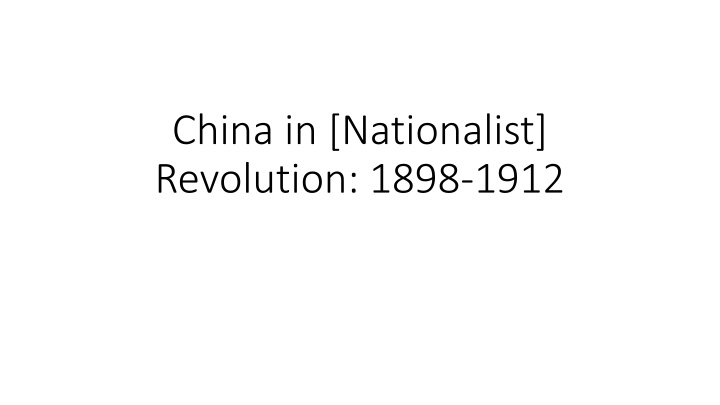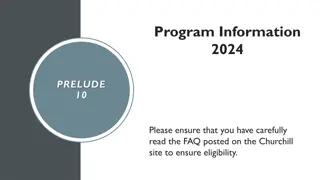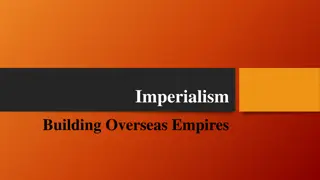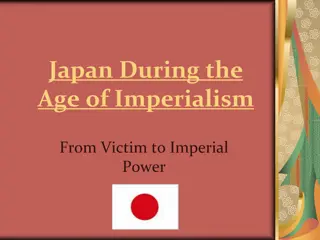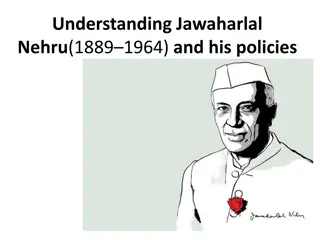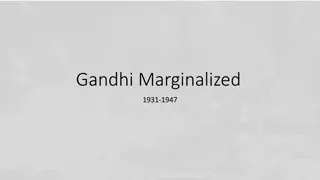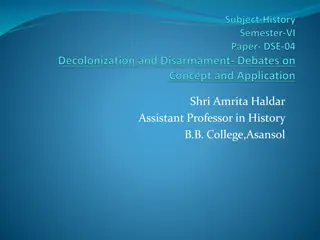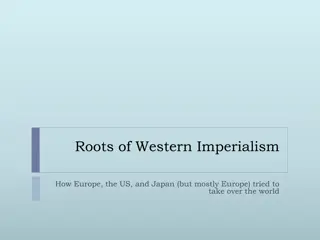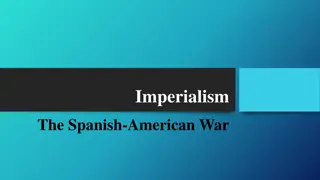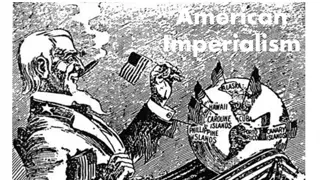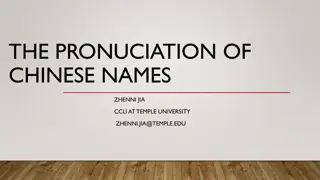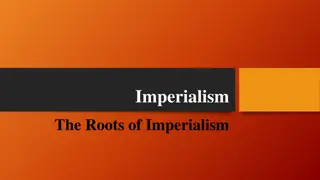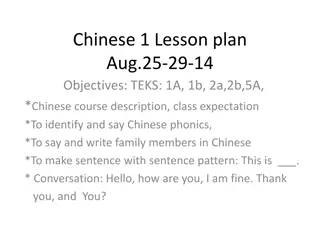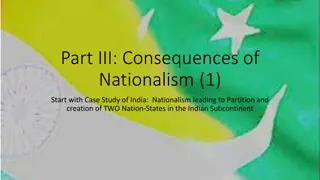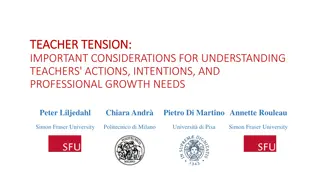Chinese Nationalist Revolution: Prelude to Internal Tensions and Imperialism Redux
Prelude to the Chinese Nationalist Revolution explores the backdrop of internal tensions and Imperialism in China from 1895 to the early 1900s. The period witnessed a series of revolts against Manchu authority, including the Taiping Rebellion and self-strengthening efforts to adopt Western technology while retaining Confucian ideologies. Imperialism's impact with territorial expansions and settlements in Treaty Ports also played a significant role in shaping China's trajectory during this era.
Download Presentation

Please find below an Image/Link to download the presentation.
The content on the website is provided AS IS for your information and personal use only. It may not be sold, licensed, or shared on other websites without obtaining consent from the author.If you encounter any issues during the download, it is possible that the publisher has removed the file from their server.
You are allowed to download the files provided on this website for personal or commercial use, subject to the condition that they are used lawfully. All files are the property of their respective owners.
The content on the website is provided AS IS for your information and personal use only. It may not be sold, licensed, or shared on other websites without obtaining consent from the author.
E N D
Presentation Transcript
China in [Nationalist] Revolution: 1898-1912
Prelude to the Chinese Nationalist Revolution: 1895-~1905 The final stages of two modalities of change in 19-20C China To review: Rebellion: The Taiping Rebellion; the Nian Rebellion; the Dongan and Panthay (Muslim) Rebellions Reform: The Self-Strengthening Reforms (Revolution) Developments in 1895-1905 A more radical reform movement: The Hundred Days Reform (1898) The Boxer Rebellion (Insurgency) 1899-1900 The Qing government s last-ditch Reforms: Xinzheng 1903-1910
INTERNAL TENSIONS: TAIPING & OTHER REVOLTS TAIPING (1840s to 1868) largest and best known, but second half of 19thC saw a SERIES of revolts against Manchu authority. NIAN (1851-1873) Northwestern Muslim revolt (1862-1873) among others WHY? ANY REVOLT has to be understood in two contexts OBJECTIVE CONDITIONS & SUBJECTIVE PERCEPTIONS OBJECTIVE conditions included Population Growth of18thC, pressure on land and fragmentation of holding Bureaucracy less under control (Corruption: impact of Opium on China) Natural disasters and flooding OPIUM trade led to outflow of silver and rise in real taxes (see previous) SUBJECTIVE PERCEPTIONS Mandate of Heaven Lost Increase in activities of TRIADS -- secret societies that blur line between self-help, rebellion, and criminality -- who stress ANTI FOREIGN nature of MANCHUS
Self Strengthening: Restoring Manchu Power? Role of Confucian Scholar-Officials such as ZENG GUOFAN and his prot g , LI HONGZHANG as well as Prince Gong and the Dowager Empress Cixi Sought to strengthen China through adoption of western technology but retain Confucian ideology and hierarchies Initial institutional changes such as the ZONGLI YAMEN Adopt Western technology, establish arsenals, shipyards, military academies, mines, factories Ultimately, a limited movement, almost doomed to fail, as not far reaching enough. Corruption, regionalism, etc., but most significantly, tried to graft western technology to a Confucian outlook. And of course, intrigues at the Imperial Court contributed their mite! Could not strengthen China enough to resist the continuing advance of Imperialism, from the West, and also, more recently, from Japan
Imperialism Redux Settlements in Treaty Ports Shanghai Park notice no dogs or Chinese allowed Missionary Activities Some positive impacts, new knowledge, but also Attacks on Confucianism, Racism, Tianjin Massacre 1870 Territorial Expansion in and around China French in Indo China British in Burma Japan and Ruyuku Islands Korea and humiliation in Sino-Japanese War, 1894
The Hundred Days Reform: 1898 Key historical figures The Hundred Days The aftermath of the Hundred Days: The legacy of Constitutionalism (the ideology of Japan/Germany style constitutional monarchy) Kang s utopia (Ideal society, ideal world) The Datongshu (Book on Ultimate Harmony)
Background and Environment of Radical Reform Radical reformers: Kang Youwei (1858-1927), Liang Qichao (1873-1929), Tan Sitong (1865-1898), Yan Fu (1853-1921) The triggering effect of the Treaty of Shimonoseki (1895): China in peril (not just Japan) and the activism of the young scholars : Kang s memorials Subsequent activities: Formation of schools and study societies; newspapers and writings, cultivating regional officials Initiation of reforms in certain provinces (e.g., Hunan) under influence and leadership of progressive governors (e.g., Huang Zunxian): Schools and reform-minded intellectual organizations (e.g., the Shiwuxuetang, or School of Current Affairs, 1897; the Nanxueshe, or Southern Learning Society, 1897-1898) and newspapers (e.g., the Xiangxuebao [Hunan Studies], Xiangbao [Hunan News], and Shiwubao [Current Affairs])
Kang Youwei Yan Fu
Tan Sitong & Liang Qichao
Ideologies of Reform: Elements of Radicalism Kang, Liang, and Tan Kang: Radical reinterpretation of Confucianism Kang: A utopian vision of the future of the world (Datongshu, or The Book of Great Harmony) the Three Worlds of Chaos, Development and Great Harmony from the Confucian classic Liyun 1887 Tan Sitong s theories of cosmic compassion (Ether), Renxue, Breaking all conventional bonds Liang Qichao: Fundamental change of institution and society; renew the people , democratic ideas
Western influences The role of the new missionaries (Timothy Richards, J. Young Allen), secularization, the social gospel, concern for China s fate, promotion of education and dissemination of ideas of change through newspapers (the Wanguo gongbao) Translation work and writing: Kang, Liang, but especially Yan Fu studied naval practices in Br. 1876, examined Br. political system and legal thought, constitutionalism, Darwin and Social Darwinism. Promoted idea of a deeper understanding of the West: not just yangwu, but that the West had a different vision of reality and strength lie in deeper cultural elements and factors (anti- tiyong view) Subsequent (1900-09) translations: Thomas Huxley, Evolution and Ethics, Adam Smith excerpts from Wealth of Nations, J.S. Mills On Liberty, Logic, Rousseau, Montesquieu, H. Spencer, Sociology
Literary translations in Classical Chinese writing style: Lin Shu (1892-1924, Aesop s Fables, Shakespeare, Chaucer, Dumas, Dickens, Walter Scott, Rider Haggard, Hugo, Jonathan Swift, Dafoe, Washington Irving, Harriet Beecher Stowe, R.L. Stevenson, Arthur Conan Doyle, Balzac, Tolstoy); Su Manshu (1884-1918, poetry of Keats, Shelley, and Wordsworth) Western modeling for reforms Idea of new nations and nation states: Chinese nationalism Development: Industrial Rev., Russia, Germany, Japan Democratic institutions: Britain, France, USA Romanticism and revolution: French Revolution, Italy
Processes in 1898 The Guangxu Emperor (r. 1875-1908) only 3 when ascended to the throne, came of age in 1889 to reign on his own, but under the influence of Empress Dowager The role of Weng Tonghe and the conservative reformers 1895-1898 Kang s 1st interview w/ high officials (Jan 1898) Allowed to present memorials (6 in the month of January; the 7th, in Feb. introduced emperor to the examples of reform in Meiji Japan and Russia (Peter the Great) June 16, 1898, Kang, attended by Liang, had audience with Guangxu, laid out ideas, convinced Guangxu about reforms, allowed to send memorials directly to the emperor June 11 to Sept 20, Hundred Days Reform
The 100 Days: June 11-Sept. 20, 1898 Education (Replacing traditional essays for new forms and subjects in the keju examination system; a modern school system to replace old academies) Political system (Abolition of unnecessary offices, simplification and efficiency, encouraging private citizens gentry to provide govt with suggestions) Industrial and commercial development Development of capital Diplomacy and foreign relations Legal codes reform Government budget Perhaps most importantly, the idea of a constitutional monarchy
The Failure and the collapse of the Reform Movement The role of the Empress Dowager Cixi; Rong Lu and Yuan Shikai (Yuan summoned by Rong at the behest of ED, to Beijing on 9/14; Tan Sitong s visit night of 9/18; 9/20, Emperor Guangxu s audience w/ Yuan, appoints him, that day, Yuan betrays the reform movt) 9/21, ED raids the emperor s palace, seizing evidence; declares that the emperor had become incapacitated due to serious illness (actually under house arrest since then) Kang and Liang had fled; Tan Sitong, Yang Rui, Liu Guangdi, Lin Xu, Kang Guangren, Yang Shenxiu beheaded, 22 others arrested, imprisoned or banished. The important legacies Constitutionalism movement Radical vision
The Boxer Rebellion:1899-1901 Background: People, organizations, locations Phases of Development: From Anti-Qing to Pro-Qing, but always Anti- Foreign ( mieyang : Destroy the foreign) The Expeditionary Army: Britain, France, Germany, Austria-Hungary, Italy, Russia, Japan The Boxer Protocol
W.A. Rogers in Harpers Magazine, 2/1900 Chinese woodblock print (The Fall of Beijing to the Allied Armies)
Origins of the Boxers Northern China: mainly Shandong, Zhili provinces The Yihequan (Righteous and Harmonious Fists) Related secret society and underground social (some millenarian) movements: The White Lotus Sect (Bailianjiao) and the Eight Trigram Sect (Baguajiao); Big Swords Society (Dadaohui); Small Swords Society (Xiaodaohui); Red Lanterns (Hongdenghui) Character, Ideology and symbolism Short-term Background Late-19C anti-monarchical and anarchistic movements Response to local disasters and economic distress Anti-Western Anti-Christian reactions to imperialism erupted 1896 in Shandong (Dadaohui in Caozhou, under Zhu Hongdeng in Dezhou) Loose federation, women groups; two German missionaries murdered in Shandong in 1896; German govt. retaliation The Yihequan, Self-defense teaching units, formed tighter organizations through ritualized relations: tan ( temples, altars ) and tuan (leagues)
Boxer Activities and Developments, 1899-1900 Mid-1899 formed league, re-named Yihetuan; still not centralized; many local leagues carrying out local disturbances Late- 1899 Shandong league first adopted slogan Support the Qing, Eliminate the Foreigners (fuqing mieyang), became a pro- dynastic anti-Western force of disturbance Rapid expansion in early-Spring 1900, esp. in Tianjin-Beijing area (800+ tan in Beijing alone) Movement reaches peak in mid-1900, threatens legations April 1900 Jt dispatch by Br., US, Fr., Germany to Qing court demanding that Boxers be eliminated Late May 1900 foreign troops begin manoeuvering into Beijing- Tianjin region to protect embassies
June 10, 1900, Joint expeditionary force (Britain, USA, France, Russia, Japan, Austria, Italy, Germany) amass in Tianjin and head toward Beijing on troop transport trains. Boxers sabotage tracks and stop troop movt at Lanfang 6/17, off shore foreign troops land, assault Tagu forts 6/18 the B. of Tianjin begins 6/20-21 Court mtg. Empress Dowager Cixi decides to use Boxers and go to war with the foreigners 7/14 Expeditionary force takes Tianjin 8/4 begins march on Beijing (20,000+ troops) 8/14 breaks into Beijing, burns the city and the summer palace compound. Qing court flees to Xian (Shaanxi) Foreign force expands to 100,000; massacres in Beijing and Tianjin, attacks Baoding and Zhangjiakou (outlying Hebei/Zhili) Russian action in Manchuria, Japanese in Shandong
Aftermath The Boxer Protocol (Dec. 1900 -1901) Punishment Indemnity Apology Destruction of fortifications Stationing of foreign troops Cession of railroads Suspension of official exams
The Last Ditch Reforms of the Qing Government: Xinzheng (New Policies) 1903-1910 Post Boxer and the terms of the Boxer Protocol The first steps: August 1900 Imperial edict; Jan. 1901 Emp. Dowager s summons; Feb. 1901 Reiteration of edict; Aug. 1901 Edict of Reform (promises) Phase 1: 1901-1905 Administration: 1901 Office of the Superintendent of Governmental Affairs Military: Establishment of the New Army and training Phase 2: 1905 and beyond Education: The modern schooling system The Abolition of the Exam System The universities of China Women s education The Issue of Constitution The Russo-Japanese War and the Tr. of Portsmouth (1905)
The Constitutional Reforms The Japanese model of constitutionalism Missions abroad (Europe, USA, Japan) 1905-1906 1906-7: The ambiguities of the Manchu court A Plan and a schedule 1907 First edict on national and provincial assemblies 1908 The Nine-year plan The death of Guangxu 11/14 and Empress Dowager Cixi 11/15 and the beginning of Xuantong s reign
The Legacy of the Xinzheng Reforms How revolutionary were these reforms? (Taking on Schoppa s interpretation, ch. 7 Revolutionary Manchus ? (Ranbir Vohra: The Manchus in charge of constitutional change ) or a last ditch New Deal to save a dying dynasty? Long-term impact of institutional reforms: Educational changes Institutional changes The Wider impact of the constitutionalist reforms Relationship between Constitutionalism and Revolution: A decade s debate The divisions within the ranks of Change & the intelligentsia: Kang, Liang, Yan, Sun, Wang, Song, and the young intellectuals Mobilization at home and overseas Constitutionalism in the provinces The Constitutionalists and the ranks of the revolution
Historical Connections: Reform, Rebellions, and Revolution Historical Figures: Empress Dowager Cixi; Qing government officials (e.g., Zhang Zhidong); Transitional figures: Chinese intellectuals (e.g., Liang Qichao; Yan Fu) and strong men (e.g., Yuan Shikai) Ideologies of Change: Constitutional reform or nationalist republican revolution? Colonialism s intensification and impact on China: Development of two modalities Britain (& US): Integral colonization (Open Door Policy, 1900) Other European powers and Japan: Partition model Scramble for Concessions since 1860s Spheres of Influences: Macro and micro Conclusion: The solution lies in revolution
